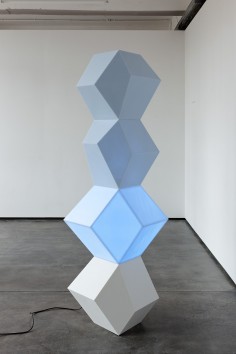ANGELA BULLOCH
Anima Eve

source: simonleegallery
Angela Bulloch’s work spans many forms, but they all manifest her interest in systems, patterns and rules, and the creative territory between mathematics and aesthetics. Since graduating from Goldsmiths’ College in 1988 as part of the ‘freeze’ generation of young British artists, her work has crystallised into a number of distinct but related strands. The ‘pixel boxes’ have become her most familiar component: initially fabricated in beech wood with a plastic front screen, their softly changing and pulsing colours at first distilled and abstracted complex visual patterns into simple shifting monochromes, and became a signature of a conceptual practice that avoided the shock strategies of many of her contemporaries. More recently, fabricated in copper, aluminium or corian they pay closer homage to their minimalist heritage, while the colours they channel are freed from their earlier origins to become pure abstraction.
Alongside these pixel box sculptures, Bulloch has also returned to the ‘Drawing Machines’ she made early in her career. Again they use a simple conceit: a machine draws vertical or horizontal lines on the gallery wall according to some external stimulus – the noise made by visitors to the exhibition, or the rhythm of their sitting on and standing from a bench placed facing the work. But this simplicity belies the rich and complex way in which the Drawing Machines bring together the modernist concerns of grid, monochrome, and colour field with a playful engagement with interactivity.
In a third strand, developed more recently, Bulloch has created electronic simulations of the night sky. The series began with her installation at the Guggenheim Museum New York for the exhibition theanyspacewhatever in 2008. For this she conceived an artificial night sky, filled with constellations of stars, to cover the interior dome of the Frank Lloyd Wright rotunda. Since then she has made numerous such pieces, from large scale public installations to small domestic panels. For each, Bulloch begins with a computerised map of the known stars of the universe, visible from earth. She selects an area of the sky based upon the primary constellations of the stars it contains and then extrapolates the view point to a location far from the earth, to create a representation of real space, but as we could never see it.
.
.
.
.
.
.
.
source: artsynet
Angela Bulloch’s sculptures and installations unite elements of architecture, industrial design, new media, and viewer interaction. She is best known for her “pixel boxes,” infinitely programmable illuminated boxes containing three fluorescent tubes capable of creating all 16 million colors of a standard computer screen. In her pixel boxes, Bulloch combines individual cubes into modular systems, as in Z-Point (2001), comprising 48 stacked boxes that create a looped abstraction of the explosion scene from Michelangelo Antonioni’s 1970 film Zabriskie Point. Other pixel boxes and sound installations explore the effects of environmental stimulus by incorporating variations that are activated by the viewer, such as in The Laughing Crowd Sound Piece (1990) where walking through a room triggers canned laughter.
.
.
.
.
.
.
.
source: ocula
Angela Bulloch is interested in systems that structure social behaviour. Her functional sculptures, light and sound works play with the ways in which we construct and interpret different types of information, be it related to art, literature, cinema, music, or issues of ownership and authorship. Her multi-disciplinary installations marry conceptual rigour with sensuousness and humour. Walking through a room triggers canned laughter; a video screening is activated by a person sitting on a cushioned bench opposite; a wall-mounted sequence of coloured spheres switches on each time a person passes a particular point.
Since early 2000 Bulloch has been creating increasingly ambitious sculptural installations made from ‘pixel boxes’. Developed by Bulloch with engineers as a prototype in the late 1990s, the pixel box is made up of luminous tubes and an electronic control unit housed within an industrially produced wooden or metal casing. Elemental units within an ever-expanding body of work, the pixel boxes form the basis of a variety of structures, from towers and floors to monumental screens which translate scenes from cinema, television or entirely abstract sequences as mesmerising colour compositions that change before the viewer.
In recent years Bulloch has realised a number of important architectural commissions, which include creating a work for the Tate Britain pier designed by Marks Barfied Architects, on the Thames at Millbank; a perforated light work embedded into the pier’s structure, which pulsed and changed colours with the rise and fall of the tide.

